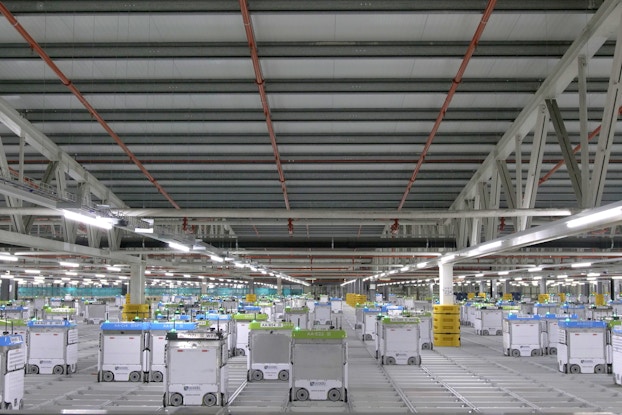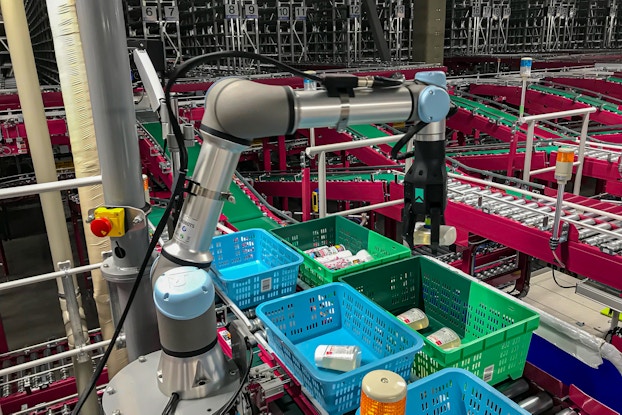
Robots have long been marching toward a takeover of the nation’s warehouses, but now they appear to be gaining speed amid COVID-19.
The COVID-19 pandemic has forced warehouse operators across industries to consider accelerating their timetables for the adoption of automation and robotics. Companies that have deployed such technologies say they can create safer workplaces by reducing interactions among workers, and that they can enhance productivity to meet increasing demands for e-commerce. Both of those objectives have come into sharp focus as the virus continues to spread throughout the country.
“[The pandemic] is teaching us that our reliance on human labor to get the job done is very risky,” Marc Wulfraat, founder and president of logistics consulting firm MWPVL International, told CO—.
As warehouses around the country have had to rethink their layouts and processes to enable social distancing between workers and protect them from infection, they have learned that such measures can cut productivity, Wulfraat said. Automated systems that can select items from bins and shelves, assemble orders of multiple items and transport them through the facility can play an important role in making warehouses safer for workers and more productive.
Although some companies may face hurdles to speedy implementation because the shutdowns around the country have slowed the permitting process for new construction in some areas, Wulfraat said he expects companies to accelerate the timelines for automating their warehouses.
“For somebody that was thinking of investing in maybe 2025, all of a sudden that's become 2022,” he said.
The surge in e-commerce during the last several months, while thousands of brick-and-mortar stores were shuttered, has been a key driver of the interest in automation, according to Wulfraat and others.
Dan Hanrahan, president of Numina Group, a Woodridge, Ill.-based warehouse automation consultancy and software solutions provider, said many warehouse operators have seen a sharp shift in their business toward direct-to-consumer shipping. This presents new challenges for operators who had been accustomed to shipping large cases to retail stores and were suddenly being asked to fulfill thousands of small orders of individual items for consumers.
In addition, smaller retailers have suddenly been competing more intensely for e-commerce sales against companies such as Amazon, Walmart and Target, which have become world-class leaders in logistics technology.
“You need to have automation because all of those [companies] spend billions on automation each year,” said Hanrahan.
[The pandemic] is teaching us that our reliance on human labor to get the job done is very risky.Marc Wulfraat, founder and president, MWPVL International
Automation helps handle heavy volumes
Radwell International, an international supplier of manufacturing parts and equipment, has been seeing the benefits of automation in its warehouses. The company has a new warehouse scheduled to open in Texas in July that, like its main headquarter-based warehouse in New Jersey, will include the AutoStoresystem from Swisslog, among other technologies, according to Brian Janusz, global procurement director at Radwell International.
The AutoStore system at the 314,000-square-foot Radwell warehouse in New Jersey includes 34 robots that scoot around autonomously on an aluminum grid, selecting items from 50,000 bins of product. The warehouse also uses a robotic box builder, which assembles cardboard boxes of various sizes and places them on conveyor belts, which carry them to the company’s human packagers. This eliminates the need for these people to spend time taping boxes together and enables greater throughput, Janusz explained. Other automation includes a package weighing system, which automatically calculates which shipping carrier to use, and a labeling machine that then applies the correct shipping label.
Interestingly, Janusz said the company did not reduce staffing as a result of the adoption of automation technology, but instead was able to realign its labor to focus on specific, more high-value functions. Radwell even added to its labor force as a result of automation, he said, citing new technicians that help keep the automated systems running properly.
The company, which also sells personal protective equipment (PPE) such as gloves and masks, saw a significant increase in orders companywide during the pandemic, and has been better able to manage the heavy order volume thanks to these automated systems, Janusz said.
“One of the reasons we went with these types of systems was to be able to handle different scenarios, where you do have a load increase,” he said. “While we’re not a seasonal company like an Amazon that relies on automation during the holidays, we know that times change quickly, and that we need to be able to adapt quickly.”
Technology
Businesses have begun automating their warehouses to streamline their processes and place less reliance on human workers. Read on for more technology tools aiding business owners in this revolutionized time.
Seeking to make grocery e-commerce profitable
Suppliers of warehouse automation systems and robotic technologies said the pandemic is focusing attention on their potential to help make e-commerce in low-margin industries, such as grocery, more profitable.
Demand for e-grocery services had been steadily growing and has ramped up during the pandemic, said Megan Wolf, director of marketing at Swisslog.
“Grocers are realizing that the e-grocery plans they made before COVID-19 now have to be re-evaluated and accelerated to meet demand and to stay competitive,” she said.
Companies in the grocery e-commerce supply chain are seeking automation solutions that are flexible and data-driven to ensure that they will not become obsolete as market conditions evolve, Wolf said. Examples include Swisslog’s own micro-fulfillment designs, which are small, automated distribution centers that are deployed closer to the consumer to allow quicker response times.
Among the highest-profile warehouse automation initiatives in the grocery sector is the partnership between Kroger Co., based in Cincinnati, and Ocado Group, the European grocery e-commerce giant. The two are planning a network of highly automated e-grocery delivery warehouses, called customer fulfillment centers, in several markets across the country, beginning early next year. They recently unveiled the three latest planned locations, measuring from 150,000 to 300,000 square feet, in the retailer’s West, Pacific Northwest and Great Lakes regions.
The robotics-driven customer fulfillment centers will “leverage advanced robotics technology and creative solutions to redefine the customer experience," said Robert Clark, Kroger's senior vice president of supply chain, manufacturing and sourcing, in a statement.
Ocado is known for its use of advanced robotics and predictive analytics for grocery e-commerce fulfillment in the U.K. It uses robotic arms with suction cups on the end, for example, to retrieve items of various shapes and sizes from bins, along with sensors that enable it to protect the integrity of the products as it picks them up and deposits them on conveyor belts.

Automating labor-intensive tasks
Picking, the function whereby specific goods are selected from warehouse shelves to fulfill customer orders, has long been one of the most labor-intensive tasks in any facility. It has therefore become one main target for automation.
At PALTAC Corp., Japan’s largest wholesaler of consumer packaged goods, a picking system from Somerville, Mass.-based RightHand Robotics features robotic grippers that reach into baskets to select items of varying shapes and sizes, using suction as they pass by on conveyor belts. It then deposits them gently in baskets on a different set of conveyor belts for packaged customer orders. Human pickers still handle the items that are too irregular for robotic grippers.
“RightPick met all of our high-level requirements,” said Masakazu Mikita, general manager of research and development, PALTAC Corp., in a case study of the deployment. “We’re confident in the system’s ability to successfully pick a wide variety of items without prior knowledge or programming.”
That’s the kind of system that many warehouse operators have been interested in, particularly for use in warehouses that have seen increased demand for direct-to-consumer fulfillment and where the current process relies on human workers standing close to one another, said Vince Martinelli, head of product and marketing at RightHand Robotics, which supplies the robotic grippers for PALTAC.
“With the increase in online shopping, they’ve realized they need a safe and efficient business model that can meet the demand for robust fulfillment and allow for spacing between human workers to enhance safety and comply with social distancing guidelines,” he said. “This is why we strongly believe that investment in robotic automation is likely to accelerate as a result of the COVID-19 pandemic.”
Critics of automation and robotics cite their potential to displace jobs currently held by humans, especially at a time when unemployment has soared to record levels. A recent report by The Brookings Institution estimated that 36 million jobs in the U.S. are at risk of being displaced by automation, and many of those positions are help by low-income and low-skilled workers. The report cites the potential for automation in the transportation and warehousing industries at 58% — higher than the 46% potential for U.S. industries overall, and lower only than the automation potential for the accommodation (lodging) and foodservices sector, and the manufacturingsector.
Wulfraat of MWPVL International said the trend toward warehouse automation is simply an evolution of the industry that will reallocate labor and reduce labor costs, but not eliminate it completely.
“The fact that we're asked to start becoming more automated — well that's no different than when the sewing machine first got invented,” he said. “You'll never eliminate people from warehouses. You'll just be able to reduce your reliance on them.”
CO— aims to bring you inspiration from leading respected experts. However, before making any business decision, you should consult a professional who can advise you based on your individual situation.
Want to read more? Be sure to follow us on LinkedIn!
CO—is committed to helping you start, run and grow your small business. Learn more about the benefits of small business membership in the U.S. Chamber of Commerce, here.

Interested in a small business membership?
Find out how the U.S. Chamber of Commerce can help your company grow and thrive in today's rapidly-evolving business environment. Connect with our team to learn how a small business membership can benefit your bottom line and help you achieve your goals.







